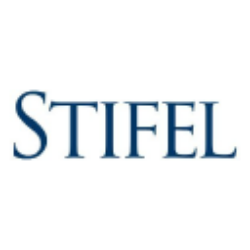LPLA

LPL Financial Holdings Inc.
LPLA
(2.8)339,13 USD
11% ROA
41.74% ROE
18.31x PER
17.846.651.859,00 USD
185.02% DER
0.5% Yield
8.73% NPM
LPL Financial Holdings Inc. Stock Analysis
LPL Financial Holdings Inc. Fundamental Analysis
Fundamental analysis in stock investing is like studying the foundation of a house before buying it. It involves looking at a company's financial health, like its earnings, assets, and debts, to determine if it's a good investment based on its fundamental strength and potential for growth.
| # | Analysis | Rating |
|---|---|---|
| 1 |
ROE
ROE surpassing expectations (54.49%) highlights strong profitability and efficient use of shareholders' equity, making it an appealing investment prospect. |
|
| 2 |
ROA
This stock has a great ability to make a lot of money from the things it owns, which makes it a really good investment for smart investors. |
|
| 3 |
Assets Growth
Over the past five years, this company's revenue has consistently increased, demonstrating a robust financial performance that makes it an appealing opportunity. |
|
| 4 |
Dividend
The company's consistent dividend distribution over the past five years reflects its dedication to providing shareholders with steady returns, making it an appealing choice for investors seeking income stability. |
|
| 5 |
Revenue Growth
This company's revenue has shown remarkable growth over the past three years, making it an excellent choice for seeking a consistently prosperous investment. |
|
| 6 |
Net Profit Growth
This company's net profit has consistently grown over the past three years, showcasing a positive financial trend and making it an appealing investment opportunity. |
|
| 7 |
Buffet Intrinsic Value
The company's stock presents an enticing opportunity as it appears undervalued (1.242) by Warren Buffett's formula, indicating that its intrinsic value exceeds the market price. |
|
| 8 |
PBV
The stock's elevated P/BV ratio (8.17x) raises concerns about its overvaluation, making it an imprudent choice for investors seeking value. |
|
| 9 |
DER
The company has a high debt to equity ratio (149%), which means it owes a lot of money compared to what it actually owns, making it financially risky. |
|
| 10 |
Graham Number
The Graham number calculation reveals that this company's stock price is potentially inflated, implying that it may not be a desirable investment option. |
|
| 11 |
Dividend Growth
The company's dividend growth has shown no improvement in the past three years, making it a less attractive investment option for those seeking increasing returns. |
LPL Financial Holdings Inc. Technical Analysis
Technical analysis in stock investing is like reading the patterns on a weather map to predict future weather conditions. It involves studying past stock price movements and trading volumes to make predictions about where a stock's price might go next, without necessarily looking at the company's financial health.
| # | Analysis | Recommendation |
|---|---|---|
| 1 | Awesome Oscillator | Buy |
| 2 | MACD | Buy |
| 3 | RSI | Hold |
| 4 | Stoch RSI | Sell |
LPL Financial Holdings Inc. Price Chart
Financial Statements
Financial statements are like report cards for companies. They show how much money a company makes (income statement), what it owns and owes (balance sheet), and where it spends its money (cash flow statement), helping stock investors understand if a company is healthy and worth investing in.
Income Statements
An income statement for a company is like a scoreboard for its profits and losses. It shows how much money the company made (revenue) and how much it spent to make that money (expenses), helping stock investors see if a company is making a profit or not.
Revenue in stock investing is the total amount of money a company earns from its sales, and it's a key factor that investors consider to assess a company's financial performance and growth potential.
| Year | Revenue | Growth |
|---|---|---|
| 2005 | 1.404.932.000 | |
| 2006 | 1.614.532.000 | 12.98% |
| 2007 | 2.593.757.000 | 37.75% |
| 2008 | 3.000.791.000 | 13.56% |
| 2009 | 2.648.583.000 | -13.3% |
| 2010 | 3.023.079.000 | 12.39% |
| 2011 | 3.410.611.000 | 11.36% |
| 2012 | 3.606.262.000 | 5.43% |
| 2013 | 4.089.412.000 | 11.81% |
| 2014 | 4.322.124.000 | 5.38% |
| 2015 | 4.215.918.000 | -2.52% |
| 2016 | 1.297.772.000 | -224.86% |
| 2017 | 1.447.810.000 | 10.36% |
| 2018 | 1.822.647.000 | 20.57% |
| 2019 | 2.042.224.000 | 10.75% |
| 2020 | 1.997.543.000 | -2.24% |
| 2021 | 2.350.303.000 | 15.01% |
| 2022 | 3.063.701.000 | 23.29% |
| 2023 | 10.089.532.000 | 69.63% |
| 2023 | 10.052.848.000 | -0.36% |
| 2024 | 11.727.076.000 | 14.28% |
Research and Development Expenses are the costs a company incurs to create and improve its products or services, which can be important for investors to evaluate a company's innovation and potential for future growth.
| Year | Research and Development Expenses | Growth |
|---|---|---|
| 2005 | 0 | |
| 2006 | 0 | 0% |
| 2007 | 0 | 0% |
| 2008 | 0 | 0% |
| 2009 | 0 | 0% |
| 2010 | 0 | 0% |
| 2011 | 0 | 0% |
| 2012 | 0 | 0% |
| 2013 | 0 | 0% |
| 2014 | 0 | 0% |
| 2015 | 0 | 0% |
| 2016 | 0 | 0% |
| 2017 | 0 | 0% |
| 2018 | 0 | 0% |
| 2019 | 0 | 0% |
| 2020 | 0 | 0% |
| 2021 | 0 | 0% |
| 2022 | 0 | 0% |
| 2023 | 0 | 0% |
| 2023 | 0 | 0% |
| 2024 | 0 | 0% |
General and Administrative Expenses are the costs a company incurs to run its day-to-day operations, such as office rent, salaries, and utilities, which investors consider to understand a company's overall efficiency and management effectiveness.
| Year | General and Administrative Expenses | Growth |
|---|---|---|
| 2005 | 182.540.000 | |
| 2006 | 181.136.000 | -0.78% |
| 2007 | 317.896.000 | 43.02% |
| 2008 | 419.667.000 | 24.25% |
| 2009 | 338.855.000 | -23.85% |
| 2010 | 382.800.000 | 11.48% |
| 2011 | 384.938.000 | 0.56% |
| 2012 | 712.917.000 | 46.01% |
| 2013 | 774.335.000 | 7.93% |
| 2014 | 844.270.000 | 8.28% |
| 2015 | 892.445.000 | 5.4% |
| 2016 | 436.557.000 | -104.43% |
| 2017 | 456.918.000 | 4.46% |
| 2018 | 506.650.000 | 9.82% |
| 2019 | 556.128.000 | 8.9% |
| 2020 | 609.257.000 | 8.72% |
| 2021 | 741.003.000 | 17.78% |
| 2022 | 820.736.000 | 9.71% |
| 2023 | 398.688.000 | -105.86% |
| 2023 | 396.920.000 | -0.45% |
| 2024 | 444.140.000 | 10.63% |
EBITDA stands for Earnings Before Interest, Taxes, Depreciation, and Amortization. It is a measure that helps stock investors analyze a company's profitability by looking at its earnings without considering certain expenses. This helps to get a clearer picture of the company's financial performance and its ability to generate cash flow.
| Year | EBITDA | Growth |
|---|---|---|
| 2005 | 109.768.000 | |
| 2006 | 245.618.000 | 55.31% |
| 2007 | 186.581.000 | -31.64% |
| 2008 | 210.567.000 | 11.39% |
| 2009 | 281.785.000 | 25.27% |
| 2010 | 87.595.000 | -221.69% |
| 2011 | 424.190.000 | 79.35% |
| 2012 | 410.687.000 | -3.29% |
| 2013 | 483.000.000 | 14.97% |
| 2014 | 481.675.000 | -0.28% |
| 2015 | 465.280.000 | -3.52% |
| 2016 | 507.957.000 | 8.4% |
| 2017 | 616.366.000 | 17.59% |
| 2018 | 865.568.000 | 28.79% |
| 2019 | 902.948.000 | 4.14% |
| 2020 | 908.928.000 | 0.66% |
| 2021 | 832.017.000 | -9.24% |
| 2022 | 1.525.264.000 | 45.45% |
| 2023 | 1.833.688.000 | 16.82% |
| 2023 | 1.985.784.000 | 7.66% |
| 2024 | 2.882.872.000 | 31.12% |
Gross profit is the money a company makes from selling its products or services after subtracting the cost of producing or providing them, and it is an important measure for investors to understand a company's profitability.
| Year | Gross Profit | Growth |
|---|---|---|
| 2005 | 1.404.932.000 | |
| 2006 | 1.614.532.000 | 12.98% |
| 2007 | 2.456.356.000 | 34.27% |
| 2008 | 2.863.390.000 | 14.22% |
| 2009 | 2.378.147.000 | -20.4% |
| 2010 | 2.714.423.000 | 12.39% |
| 2011 | 3.410.611.000 | 20.41% |
| 2012 | 1.025.119.000 | -232.7% |
| 2013 | 3.546.204.000 | 71.09% |
| 2014 | 3.755.681.000 | 5.58% |
| 2015 | 3.588.996.000 | -4.64% |
| 2016 | 663.096.000 | -441.25% |
| 2017 | 783.860.000 | 15.41% |
| 2018 | 1.054.496.000 | 25.66% |
| 2019 | 1.210.712.000 | 12.9% |
| 2020 | 1.097.472.000 | -10.32% |
| 2021 | 1.350.538.000 | 18.74% |
| 2022 | 1.950.648.000 | 30.76% |
| 2023 | 3.061.596.000 | 36.29% |
| 2023 | 3.051.376.000 | -0.33% |
| 2024 | 3.912.608.000 | 22.01% |
Net income in stock investing is like the money a company actually gets to keep as profit after paying all its bills, and it's an important measure to understand how well a company is doing financially.
| Year | Net Profit | Growth |
|---|---|---|
| 2005 | 43.089.000 | |
| 2006 | 33.642.000 | -28.08% |
| 2007 | 61.069.000 | 44.91% |
| 2008 | 45.496.000 | -34.23% |
| 2009 | 47.520.000 | 4.26% |
| 2010 | -56.862.000 | 183.57% |
| 2011 | 170.382.000 | 133.37% |
| 2012 | 151.918.000 | -12.15% |
| 2013 | 181.857.000 | 16.46% |
| 2014 | 178.043.000 | -2.14% |
| 2015 | 168.784.000 | -5.49% |
| 2016 | 191.931.000 | 12.06% |
| 2017 | 238.863.000 | 19.65% |
| 2018 | 439.459.000 | 45.65% |
| 2019 | 559.880.000 | 21.51% |
| 2020 | 472.640.000 | -18.46% |
| 2021 | 459.866.000 | -2.78% |
| 2022 | 845.702.000 | 45.62% |
| 2023 | 897.164.000 | 5.74% |
| 2023 | 1.066.250.000 | 15.86% |
| 2024 | 975.200.000 | -9.34% |
EPS, or earnings per share, is a measure that shows how much profit a company has earned for each outstanding share of its stock, and it is important for stock investors as it helps understand the profitability of a company and compare it with other companies in the market.
| Year | Earning per Share (EPS) | Growth |
|---|---|---|
| 2005 | 1 | |
| 2006 | 0 | 0% |
| 2007 | 1 | 0% |
| 2008 | 1 | 0% |
| 2009 | 1 | 0% |
| 2010 | -1 | 0% |
| 2011 | 2 | 100% |
| 2012 | 1 | 0% |
| 2013 | 2 | 0% |
| 2014 | 2 | 0% |
| 2015 | 2 | 0% |
| 2016 | 2 | 50% |
| 2017 | 3 | 0% |
| 2018 | 5 | 50% |
| 2019 | 7 | 33.33% |
| 2020 | 6 | -20% |
| 2021 | 6 | 0% |
| 2022 | 11 | 50% |
| 2023 | 12 | 9.09% |
| 2023 | 14 | 15.38% |
| 2024 | 13 | 0% |
Cashflow Statements
Cashflow statements show the movement of money in and out of a company, helping stock investors understand how much money a company makes and spends. By examining cashflow statements, investors can assess if a company is generating enough cash to pay its bills, invest in growth, and provide returns to stockholders.
Free cash flow is the leftover cash that a company generates after covering its operating expenses and capital expenditures, which is important for stock investors as it shows how much money a company has available to invest in growth, pay dividends, or reduce debt.
| Year | Free Cashflow | Growth |
|---|---|---|
| 2005 | 98.571.000 | |
| 2006 | 116.188.000 | 15.16% |
| 2007 | -64.666.000 | 279.67% |
| 2008 | 26.465.000 | 344.35% |
| 2009 | 262.844.000 | 89.93% |
| 2010 | -46.009.000 | 671.29% |
| 2011 | 406.031.000 | 111.33% |
| 2012 | 199.482.000 | -103.54% |
| 2013 | 81.878.000 | -143.63% |
| 2014 | 133.594.000 | 38.71% |
| 2015 | 206.886.000 | 35.43% |
| 2016 | 147.191.000 | -40.56% |
| 2017 | 171.548.000 | 14.2% |
| 2018 | 420.964.000 | 59.25% |
| 2019 | 467.482.000 | 9.95% |
| 2020 | 634.409.000 | 26.31% |
| 2021 | 237.147.000 | -167.52% |
| 2022 | 1.638.981.000 | 85.53% |
| 2023 | -91.400 | 1793295.84% |
| 2023 | 109.325.000 | 100.08% |
| 2024 | -277.751.000 | 139.36% |
Operating cash flow represents the cash generated or consumed by a company's day-to-day operations, excluding external investing or financing activities, and is crucial for stock investors as it shows how much cash a company is generating from its core business operations.
| Year | Operating Cashflow | Growth |
|---|---|---|
| 2005 | 117.995.000 | |
| 2006 | 139.226.000 | 15.25% |
| 2007 | 10.072.000 | -1282.31% |
| 2008 | 89.277.000 | 88.72% |
| 2009 | 271.157.000 | 67.08% |
| 2010 | -22.914.000 | 1283.37% |
| 2011 | 442.378.000 | 105.18% |
| 2012 | 254.268.000 | -73.98% |
| 2013 | 160.117.000 | -58.8% |
| 2014 | 232.242.000 | 31.06% |
| 2015 | 279.451.000 | 16.89% |
| 2016 | 274.837.000 | -1.68% |
| 2017 | 443.779.000 | 38.07% |
| 2018 | 581.580.000 | 23.69% |
| 2019 | 623.871.000 | 6.78% |
| 2020 | 789.941.000 | 21.02% |
| 2021 | 453.134.000 | -74.33% |
| 2022 | 1.945.577.000 | 76.71% |
| 2023 | -91.400 | 2128740.04% |
| 2023 | 512.611.000 | 100.02% |
| 2024 | -148.829.000 | 444.43% |
Capex, short for capital expenditures, refers to the money a company spends on acquiring or upgrading tangible assets like buildings, equipment, or technology, which is important for stock investors as it indicates how much a company is investing in its infrastructure to support future growth and profitability.
| Year | Capital Expenditure | Growth |
|---|---|---|
| 2005 | 19.424.000 | |
| 2006 | 23.038.000 | 15.69% |
| 2007 | 74.738.000 | 69.17% |
| 2008 | 62.812.000 | -18.99% |
| 2009 | 8.313.000 | -655.59% |
| 2010 | 23.095.000 | 64.01% |
| 2011 | 36.347.000 | 36.46% |
| 2012 | 54.786.000 | 33.66% |
| 2013 | 78.239.000 | 29.98% |
| 2014 | 98.648.000 | 20.69% |
| 2015 | 72.565.000 | -35.94% |
| 2016 | 127.646.000 | 43.15% |
| 2017 | 272.231.000 | 53.11% |
| 2018 | 160.616.000 | -69.49% |
| 2019 | 156.389.000 | -2.7% |
| 2020 | 155.532.000 | -0.55% |
| 2021 | 215.987.000 | 27.99% |
| 2022 | 306.596.000 | 29.55% |
| 2023 | 0 | 0% |
| 2023 | 403.286.000 | 100% |
| 2024 | 128.922.000 | -212.81% |
Balance Sheet
Balance sheets provide a snapshot of a company's financial health and its assets (such as cash, inventory, and property) and liabilities (like debts and obligations) at a specific point in time. For stock investors, balance sheets help assess the company's overall worth and evaluate its ability to meet financial obligations and support future growth.
Equity refers to the ownership interest or stake that shareholders have in a company, representing their claim on its assets and earnings after all debts and liabilities are paid.
| Year | Equity | Growth |
|---|---|---|
| 2006 | 626.917.000 | |
| 2007 | 747.166.000 | 16.09% |
| 2008 | 790.312.000 | 5.46% |
| 2009 | 850.875.000 | 7.12% |
| 2010 | 1.173.755.000 | 27.51% |
| 2011 | 1.344.748.000 | 12.72% |
| 2012 | 1.140.020.000 | -17.96% |
| 2013 | 1.099.971.000 | -3.64% |
| 2014 | 971.600.000 | -13.21% |
| 2015 | 715.610.000 | -35.77% |
| 2016 | 1.540.472.000 | 53.55% |
| 2017 | 1.826.887.000 | 15.68% |
| 2018 | 1.883.334.000 | 3% |
| 2019 | 2.196.331.000 | 14.25% |
| 2020 | 2.108.035.000 | -4.19% |
| 2021 | 2.643.571.000 | 20.26% |
| 2022 | 1.973.158.001 | -33.98% |
| 2023 | 3.455.890.999 | 42.9% |
| 2023 | 2.090.588.000 | -65.31% |
| 2024 | 2.515.347.000 | 16.89% |
Assets represent the valuable resources that a company owns, such as cash, inventory, property, and equipment, and understanding a company's assets helps investors assess its value and potential for generating future profits.
| Year | Assets | Growth |
|---|---|---|
| 2006 | 2.797.544.000 | |
| 2007 | 3.287.349.000 | 14.9% |
| 2008 | 3.381.779.000 | 2.79% |
| 2009 | 3.336.936.000 | -1.34% |
| 2010 | 3.646.167.000 | 8.48% |
| 2011 | 3.816.326.000 | 4.46% |
| 2012 | 3.988.524.000 | 4.32% |
| 2013 | 4.042.831.000 | 1.34% |
| 2014 | 4.050.993.000 | 0.2% |
| 2015 | 4.517.763.000 | 10.33% |
| 2016 | 4.834.926.000 | 6.56% |
| 2017 | 5.358.751.000 | 9.78% |
| 2018 | 5.477.468.000 | 2.17% |
| 2019 | 5.880.238.000 | 6.85% |
| 2020 | 6.523.571.000 | 9.86% |
| 2021 | 7.991.600.000 | 18.37% |
| 2022 | 9.482.226.000 | 15.72% |
| 2023 | 10.385.480.000 | 8.7% |
| 2023 | 9.487.329.000 | -9.47% |
| 2024 | 11.503.727.000 | 17.53% |
Liabilities refer to the financial obligations or debts that a company owes to creditors or external parties, and understanding a company's liabilities is important for investors as it helps assess the company's financial risk and ability to meet its obligations.
| Year | Liabilities | Growth |
|---|---|---|
| 2006 | 2.170.627.000 | |
| 2007 | 2.540.183.000 | 14.55% |
| 2008 | 2.591.467.000 | 1.98% |
| 2009 | 2.486.061.000 | -4.24% |
| 2010 | 2.472.412.000 | -0.55% |
| 2011 | 2.471.578.000 | -0.03% |
| 2012 | 2.848.504.000 | 13.23% |
| 2013 | 2.942.860.000 | 3.21% |
| 2014 | 3.079.393.000 | 4.43% |
| 2015 | 3.802.153.000 | 19.01% |
| 2016 | 4.013.931.000 | 5.28% |
| 2017 | 4.393.743.000 | 8.64% |
| 2018 | 4.503.395.000 | 2.43% |
| 2019 | 4.856.365.000 | 7.27% |
| 2020 | 5.208.717.000 | 6.76% |
| 2021 | 6.321.067.000 | 17.6% |
| 2022 | 7.314.674.000 | 13.58% |
| 2023 | 8.306.501.000 | 11.94% |
| 2023 | 7.396.741.000 | -12.3% |
| 2024 | 8.988.380.000 | 17.71% |
LPL Financial Holdings Inc. Financial Ratio (TTM)
Valuation Metrics
- Revenue per Share
- 146.28
- Net Income per Share
- 13.04
- Price to Earning Ratio
- 18.31x
- Price To Sales Ratio
- 1.63x
- POCF Ratio
- 31.86
- PFCF Ratio
- 163.65
- Price to Book Ratio
- 7.09
- EV to Sales
- 1.81
- EV Over EBITDA
- 8.57
- EV to Operating CashFlow
- 35.31
- EV to FreeCashFlow
- 181.28
- Earnings Yield
- 0.05
- FreeCashFlow Yield
- 0.01
- Market Cap
- 17,85 Bil.
- Enterprise Value
- 19,77 Bil.
- Graham Number
- 99.38
- Graham NetNet
- -49.25
Income Statement Metrics
- Net Income per Share
- 13.04
- Income Quality
- 0.57
- ROE
- 0.44
- Return On Assets
- 0.08
- Return On Capital Employed
- 0.23
- Net Income per EBT
- 0.75
- EBT Per Ebit
- 0.68
- Ebit per Revenue
- 0.17
- Effective Tax Rate
- 0.25
Margins
- Sales, General, & Administrative to Revenue
- 0.04
- Research & Developement to Revenue
- 0
- Stock Based Compensation to Revenue
- 0.01
- Gross Profit Margin
- 0.32
- Operating Profit Margin
- 0.17
- Pretax Profit Margin
- 0.12
- Net Profit Margin
- 0.09
Dividends
- Dividend Yield
- 0.01
- Dividend Yield %
- 0.5
- Payout Ratio
- 0.09
- Dividend Per Share
- 1.2
Operating Metrics
- Operating Cashflow per Share
- 7.49
- Free CashFlow per Share
- 1.46
- Capex to Operating CashFlow
- 0.81
- Capex to Revenue
- 0.04
- Capex to Depreciation
- 1.16
- Return on Invested Capital
- 0.2
- Return on Tangible Assets
- 0.11
- Days Sales Outstanding
- 105.51
- Days Payables Outstanding
- 131.85
- Days of Inventory on Hand
- -2.25
- Receivables Turnover
- 3.46
- Payables Turnover
- 2.77
- Inventory Turnover
- -162.03
- Capex per Share
- 6.03
Balance Sheet
- Cash per Share
- 39,63
- Book Value per Share
- 33,66
- Tangible Book Value per Share
- -1.71
- Shareholders Equity per Share
- 33.66
- Interest Debt per Share
- 65.32
- Debt to Equity
- 1.85
- Debt to Assets
- 0.4
- Net Debt to EBITDA
- 0.83
- Current Ratio
- 2.06
- Tangible Asset Value
- -0,13 Bil.
- Net Current Asset Value
- -2,64 Bil.
- Invested Capital
- 7062894000
- Working Capital
- 3,26 Bil.
- Intangibles to Total Assets
- 0.23
- Average Receivables
- 3,15 Bil.
- Average Payables
- 2,75 Bil.
- Average Inventory
- -30195500
- Debt to Market Cap
- 0.26
Dividends
Dividends in stock investing are like rewards that companies give to their shareholders. They are a portion of the company's profits distributed to investors, typically in the form of cash payments, as a way for them to share in the company's success.
| Year | Dividends | Growth |
|---|---|---|
| 2012 | 2 | |
| 2013 | 1 | 0% |
| 2014 | 1 | 0% |
| 2015 | 1 | 100% |
| 2016 | 1 | 0% |
| 2017 | 1 | 0% |
| 2018 | 1 | 0% |
| 2019 | 1 | 0% |
| 2020 | 1 | 0% |
| 2021 | 1 | 0% |
| 2022 | 1 | 0% |
| 2023 | 1 | 0% |
| 2024 | 1 | 0% |
LPL Financial Holdings Inc. Profile
About LPL Financial Holdings Inc.
LPL Financial Holdings Inc., together with its subsidiaries, provides an integrated platform of brokerage and investment advisory services to independent financial advisors and financial advisors at financial institutions in the United States. Its brokerage offerings include variable and fixed annuities, mutual funds, equities, retirement and education savings plans, fixed income, and insurance, as well as alternative investments, such as non-traded real estate investment trusts and auction rate notes. The company also provides advisory platforms that provide access to mutual funds, exchange-traded funds, stocks, bonds, certain option strategies, unit investment trusts, and institutional money managers and no-load multi-manager variable annuities. In addition, it offers money market programs; and retirement solutions for commission-and fee-based services that allow advisors to provide brokerage services, consultation, and advice to retirement plan sponsors. Further, the company provides other services comprising tools and services that enable advisors to maintain and grow their practices; trust, investment management oversight, and custodial services to trusts for estates and families, as well as insurance brokerage general agency services; and technology products, such as proposal generation, investment analytics, and portfolio modeling. The company was formerly known as LPL Investment Holdings Inc. and changed its name to LPL Financial Holdings Inc. in June 2012. LPL Financial Holdings Inc. was founded in 1989 and is based in San Diego, California.
- CEO
- Mr. Richard Steinmeier
- Employee
- 8.787
- Address
-
4707 Executive Drive
San Diego, 92121
LPL Financial Holdings Inc. Executives & BODs
| # | Name | Age |
|---|---|---|
| 1 |
Mr. Greg Gates MD and Chief Technology & Information Officer |
70 |
| 2 |
Robert Krivit Senior Vice President & Head of Trading |
70 |
| 3 |
Ms. Aneri Jambusaria CFP Managing Director of LPL Services Group |
70 |
| 4 |
Mr. Richard Steinmeier Chief Executive Officer, MD, Chief Growth Officer & Director |
70 |
| 5 |
Ms. Judith Kohoskie Ricketts Executive Vice President of Operations |
70 |
| 6 |
Ms. Sara Dadyar MD & Chief Human Capital Officer |
70 |
| 7 |
Ms. Althea Brown MD & Chief Legal Officer |
70 |
| 8 |
Mr. Matthew Jon Audette B.S. President, Chief Financial Officer & Head of Business Operations |
70 |
| 9 |
Mr. Matthew K. Enyedi Managing Director of Client Success |
70 |
| 10 |
Mr. Marc Andrew Zabicki C.F.A. Chief Investment Officer |
70 |










